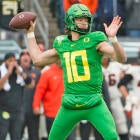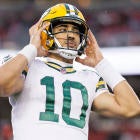The Los Angeles Chargers made some major changes this offseason. They moved on from longtime starting quarterback Philip Rivers and running back Melvin Gordon, committing instead to their backups, Tyrod Taylor and Austin Ekeler. At least, that's how it seemed heading into the draft.
The Chargers, despite insisting all offseason that they were committed to Taylor, ended up using the No. 6 overall pick on Oregon quarterback Justin Herbert. It presumably will not be long before Herbert becomes the team's starter, even if Taylor ends up beginning the 2020 season under center.
Unlike some of the other quarterbacks drafted in the first round, Herbert will have a strong offensive infrastructure around him whenever he takes over. The Chargers have a top receiver duo, a strong pass-catching running back, and a system that plays to the strengths of those players. Herbert won't be asked to carry the offense on his own, and because the Chargers have Taylor in place, he also won't be asked to take over until he's actually ready.
The Chargers' decision to trade up later in the first round for linebacker Kenneth Murray helped fill another need, but also cost them a chance to address additional positions later on in the draft. He also may not have been the best linebacker on the board, being that LSU's Patrick Queen was considered superior in coverage. In sacrificing that draft capital, the Chargers also gave up the ability to do some of the following things.
1. Fix the tackle issue
The Chargers made a couple of quality offensive line additions during the offseason, signing right tackle Bryan Bulaga away from the Packers and trading left tackle Russell Okung to the Panthers in exchange for guard Trai Turner. Those movies solidified the right side of the team's line, but also left the team with a hole at left tackle.
They had a chance to fill that hole with the No. 6 overall pick, but instead chose to select their quarterback of the future in Justin Herbert. That's a perfectly justifiable choice, but the Chargers then did not address the tackle position at all in the rest of the draft, and in sacrificing two picks for one to trade up for Kenneth Murray, also gave up an extra selection that could have been used on a tackle. Unless Bulaga is switching to the left side for the first time in his career, Sam Tevi or Trey Pipkins looks like this team's starting left tackle. That's not good news for Herbert or Tyrod Taylor.
2. Add a quality third wideout
Keenan Allen is one of the best wide receivers in football. Mike Williams is a quality No. 2, thought he has dealt with injuries issues throughout his career. But as we saw last season, the Chargers do not have much in the way of depth at the receiver position. At the moment, it looks like either Jalen Guyton or Andre Patton will be the team's No. 3 wideout in 2020.
L.A. took two wideouts on Day 3 of the draft, but seventh-rounder K.J. Hill was the only receiver in the class (out of the 21 for whom we had appropriate data) who graded out below-average in both athleticism (SPARQ) and production (Yards Per Route Run), and fifth-rounder Joe Reed is a late breakout who averaged 8.8 yards per reception last season. Neither seems likely to be that much of an upgrade over what the Chargers had in house already.
3. Find a successor for Melvin Ingram
The Chargers have one of the best edge rushing duos in the NFL in Joey Bosa and Melvin Ingram, but both players are up for new contracts following the 2020 season. Bosa is younger and the better player, and thus is more likely to be the one who gets paid. The Chargers have to make choices about which of their players they're going to give long-term deals, and being that Ingram will be 32 next offseason, he's likely not going to be among that group. It would be a far better idea to pay Bosa, Derwin James, and Desmond King, for example.
But instead of finding a potential successor to Ingram on Day 2 or 3, the Chargers took a running back who is unlikely to contribute over the two incumbents, a safety who has at least four players ahead of him in the rotation, and two wide receivers who may not even solve their receiver depth issue. One of those picks could have been better utilized on the edge.

















